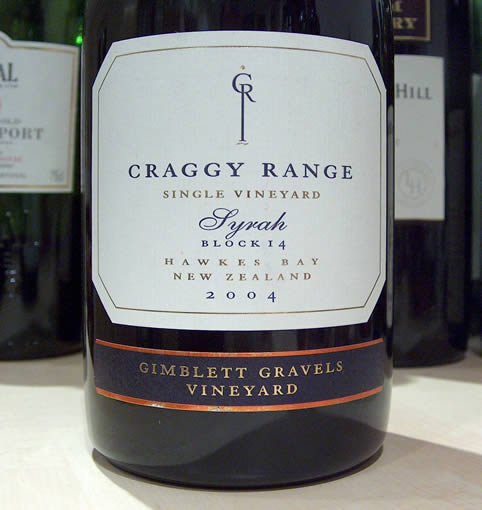|
Extended tasting note
Craggy
Range Single Vineyard Syrah Block 14 2004 Hawkes Bay, New Zealand

This is a wine Iíve had a bit of experience with, and the reason
Iím drinking it tonight is because itís a wine I like. So this is
not a neutral tasting note. Itís a bit of vinous cheerleading, if
you will.
Now Iím a big fan of Northern RhŰne Syrah. Shiraz,
the name this wine goes by in the new world, also works for me, but
perhaps less often. In too-warm climates, Syrah loses a bit of the
freshness, meatiness and pepperiness that I admire in this grape
variety. The fact that a new world wine is labelled Syrah rather than
Shiraz suggests to me that the winemaker realizes there is a bit of a
stylistic division, and so Iím much more inclined to try the wine,
given my stylistic bias.
I first came across Craggy Rangeís Syrah at a tasting
with Steve Smith MW, the dude behind Craggyís remarkable wines
(described accurately by Jay McInerney as Ďa polar bear of a
maní), earlier this year. I then retasted the wine at a retailer
tasting (winedirect.co.uk), once more when I did some wine tasting
videos with this retailer, and then again when I visited Craggy in
November. Each time I have been really impressed.
So today, when I visited a branch of Waitrose (UK
supermarket), I decided to treat myself to a bottle. At £14.99 it
isnít cheap, but for the quality, this is very good value. I think
itís important to actually put your hand in your pocket and buy
wines on a regular basis if you want to be a critic that actually
understands how your readers feel about buying wine.
So, in this domestic setting, how does the wine stack
up? First, I must describe the context. Iíve been drinking the wine
for a couple of hours as I write. Iíve been eating a bit of
cave-aged Gruyere, too, which I know I shouldnít, because red wine
and cheese arenít supposed to be a good match. Itís now 11 pm, and
Iím feeling relaxed but a little tired. Still, Iím an evening sort
of person, and function well late at night, usually dipping off in
terms of concentration just after midnight, when I stop working.
But for me, work is like leisure. I enjoy it. I
wouldnít want to work all the time, and I recognize that balance is
one of the keys to a healthy existence. I donít really like a 9Ė5
routine, so I donít have a problem with working late and then doing
other stuff when most people are working, if you see what I mean.
The Gimblett Gravels, where this wine comes from,
represent a special terroir within the Hawkes Bay wine region. They
are free draining, as youíd expect from gravel, and the vineyards
here are well set up to ripen red varieties that struggle to ripen
elsewhere in New Zealand. This Syrah comes from the gravels, and it is
a deep coloured wine. I should add that it is sealed with a cork Ė
fortunately, in this case, a good quality one that lacks taint.
The nose has a lovely aromatic quality. It has a
delicious peppery freshness, along with ripe, dark, slightly meaty
fruits. Thereís a nice combination of fresher red fruits with
sweeter, richer black fruits, and Iím also getting a little of that
floral, violet character thatís often attributed to Syrah. The
palate shows great balance, with the fruit sweetness countered nicely
by good acidity, some grippy tannins and a nice spiciness. This is
definitely leaning more in the direction of the northern RhŰne than
it is of the Barossa Valley, although there is some new world-style
sweet, pure fruit evident. Itís a tremendously enjoyable wine with
more than a hint of seriousness to it. Wines like this will certainly
make the world realize that there is much, much more to New Zealand
than just Sauvignon Blanc and aromatic whites. If I were to score
this, it would probably rate 92/100, although my scores shouldnít be
seen as any more than a shorthand for how much I liked the wine on the
occasion when I tried it.
What about ageing? I think this wine will age, but I
reckon itís pretty good now, and I donít see what it would really
gain from further time. It has got something to lose, though Ė all
that vibrant, fresh fruit. For this reason Iíd say drink it now, or
over the next two years.
Other
ETNs:
De
Bortoli Shiraz; GrŁnhaus;
Roc des Anges; Gaillard;
Veratina; Arturo;
Wynns; Drystone;
Foundry and Columella; Meruge;
Foillard Morgon; Clonakilla;
Latour 1934; Thevenet
Bongran
tasted
12/07
Back to top
|

